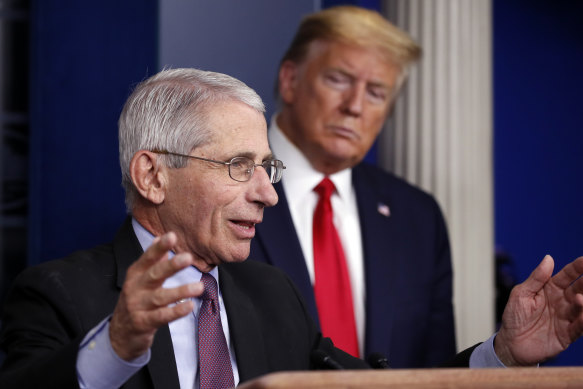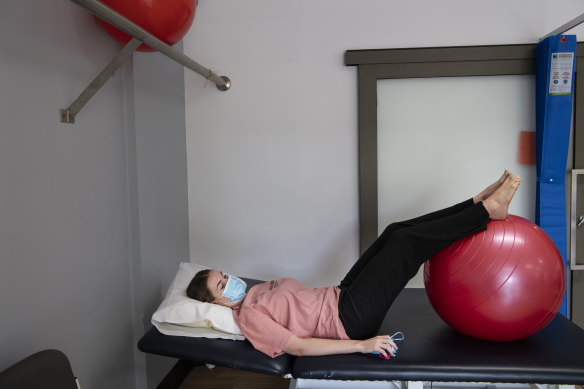We’re in the hydroxychloroquine era of long COVID

Examine, a free weekly newsletter covering science with a sceptical, evidence-based eye, is sent every Tuesday. Below is an excerpt – sign up to get the whole newsletter in your inbox.
In March 2020, in the embryonic days of the pandemic-that-would-change-everything, then-US president Donald Trump took to the stage to introduce the world to a “game changing” new drug: hydroxychloroquine.
There was no evidence the drug worked to treat COVID-19, his exasperated chief medical advisor Anthony Fauci was forced to note. But Trump said he had a “good feeling about it”. After all, “if things don’t go as planned, it’s not going to kill anybody”. (He was wrong.)
Trump quickly soured on medical expert Anthony Fauci.Credit:AP
Hype, hopelessness, misinformation, madness. It seems a lifetime ago, doesn’t it? Yet for millions who suffer from long COVID, that time has never ended.
We don’t fully understand what causes the debilitating condition and we don’t know how to treat it. Patients have taken to testing treatments on themselves and sharing the results online.
“We’re at the hydroxychloroquine stage with long COVID – the stage where people come up with unproven and crazy ideas,” Professor Steven Faux, co-lead of the long COVID clinic at Sydney’s St Vincent’s Hospital, tells me. It’s a sign of the times, I suspect, that many patients are gravitating to ivermectin.
But doctors can’t offer their patients nothing while they wait for trials to be done. So, many clinics are using a treatment already deeply controversial in the myalgic encephalomyelitis/chronic fatigue syndrome (ME/CFS) community: graded exercise therapy.
A patient at St Vincent’s long COVID Clinic, March 2022.Credit:Louise Kennerley
Believe the patients?
Graded exercise therapy involves slowly building a person’s strength through movement. It was prescribed for people with ME/CFS based on the theory that their muscles had become “deconditioned” after long periods of rest, and that when patients started moving again, they misinterpreted normal pains as symptoms of the disease.
In 2011, the Lancet published a large randomised trial of treatments for ME/CFS, including graded exercise therapy. The study concluded the treatment was moderately better than standard care. An earlier Cochrane review (that did not include the Lancet study) came to a similar conclusion.
But here’s the thing: many people with ME/CFS are deeply critical of graded exercise therapy, for two reasons.
First, a proportion have post-exertional malaise: being forced to exercise can leave them bedridden for days. Second, there’s a sense the therapy is based on the idea that their condition is not real.
“When they are forced by their doctor to do graded exercise therapy, they get worse – they crash,” says Anne Wilson, CEO of ME/CFS advocacy organisation Emerge Australia. “Doctors and clinicians say they know better. Why believe the patients?
“You’re being told when you get more physically fit your ME/CFS symptoms will improve. Bullshit.”
The Lancet study became controversial almost as soon as it hit the internet. Patients, organisations and experts shredded it in open letters. Freedom of information applications were filed.
Perhaps the most damning criticism I have seen is that the scientists changed the measures they were using to decide if a patient had “recovered”, after the trial had started. In general, this is a big no-no because it can allow researchers to manipulate a study to get the result they wanted. (The researchers offer a defence here.)
When independent scientists reanalysed the Lancet’s data using the original outcome measures, any effect from graded exercise therapy disappeared. Worse, when other scientists asked to see the raw data from the Lancet study, they were basically told to go away.
Now, none of this is to say graded exercise therapy won’t work for long COVID. We just don’t have the data. Several clinics say, anecdotally, they are having success. This story is more a marker of the confusing times we’re in.
“It is really important to state that whilst ME/CFS shares many similarities to long COVID, they are not the same illness,” says Associate Professor Anthony Byrne from the St Vincent’s clinic. “Important differences in pathophysiology and disease are known. It is not correct nor appropriate to interchange the two, particularly in terms of exercise.”
Byrne pointed me to a small study he’d published showing the therapy was at least safe for long COVID patients (the study was not big enough to show effectiveness).
Another important point: different long COVID patients seem to have different symptoms, and only some report post-exertional malaise. “There is a subgroup of people who have seen benefit from graded exercise therapy,” Alexia Koutoulas, an exercise physiologist at the Royal Melbourne Hospital’s long COVID clinic tells me. But even then, it’s not straightforward: some spontaneously develop post-exertional malaise.
Steven Faux started by offering all his long COVID patients exercise therapy. “We indeed saw some young people suffering from it.” So he changed his approach, individualising treatment, “mindful that building them up suddenly might not always be the right thing to do”.
Recovery and RECOVERY
There are more than two dozen trials of treatments for long COVID right now, many focusing on anti-inflammatory drugs.
That’s the good news. The note of caution is: we’ve been here before and fumbled the ball.
When the pandemic started, researchers around the world launched thousands of small studies that were not big enough, nor well enough designed to be able to tell us if the treatments actually helped patients get better. Australia somehow did even worse: we spent millions on trials that often couldn’t even manage to recruit 10 patients, and largely learnt nothing.
It took RECOVERY, a large randomised, controlled trial that linked hospitals in the UK’s National Health Service, to show that hydroxychloroquine did not work; weeks later it would uncover a cheap medicine, dexamethasone, that dramatically reduced mortality. This trial changed the course of the pandemic.
Australia has a pool of long COVID patients. We have high-quality expertise in clinical trials and immunology. “I absolutely think we could do a RECOVERY,” says The Alfred Hospital’s head of respiratory medicine research, Professor Anne Holland. “We have the infrastructure for it.”
But chronic conditions are harder to trial than acute illnesses. And we lack a solid definition and well-established biomarkers to indicate when a patient has long COVID; it’s possible (likely?) there are multiple “long COVIDs” with different and interacting causes. A long COVID RECOVERY is going to be tricky.
The other question is political will. There is an opportunity for Australia to become a leader in long COVID research – and post-viral illness more broadly. The former federal government allocated some money to long COVID research in 2021; major investment would make us a major player. The National Health and Medical Research Council, Australia’s key health research funder, tells me it has only two projects on the books, each worth less than $1 million. The federal health department lists another $8 million or so worth of COVID research, although it’s not clear how focused that is on long COVID.
“Research depends on funding, and we haven’t seen any specific funding pathways,” says Associate Professor Shidan Tosif, part of the long COVID team at the Royal Children’s Hospital in Melbourne. “We would be ready and keen to support research – it’s just the funding call has not come yet.”
Enjoyed this article? The Examine newsletter explains and analyses science with a rigorous focus on the evidence. Sign up to get it each week.
Most Viewed in National
From our partners
Source: Read Full Article

